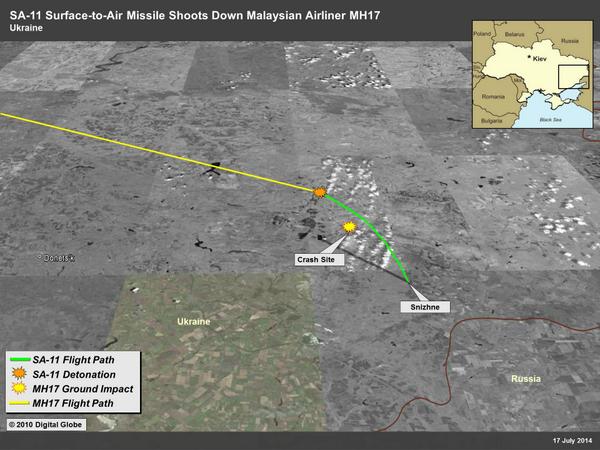The Sydney Morning Herald: 22. July 2014
By Rose Powell
Russia’s attempts to pin the MH17 crash on a missile fired by a Ukrainian plane have been debunked by defence experts across the world.
A key image has emerged that confirms MH17 was most likely shot out of the sky by a surface-to-air missile based on the severity and pattern of the damage wrought on the charred sheet of metal covered in small perforations with a gaping hole at its centre.
Ballistics specialist and senior lecturer at ANU Strategic Defence Studies Centre Stephan Fruhling told Fairfax Media the damage pattern confirmed it was a surface-to-air missile such as an SA-11.
Damage to plane consistent with that inflicted by surface-to-air missile: A part of the wreckage is seen at the crash site of MH17. Photo: Reuters
A part of the wreckage is seen at the crash site of the Malaysia Airlines Flight MH17.
Damage to plane consistent with that inflicted by surface-to-air missile: A part of the wreckage is seen at the crash site of MH17.

SA-11 missiles are 70 kilograms of high-powered explosives wrapped in steel bars. They have a proximity fuse in the head, which triggers the weapon to explode close to the aircraft, showering it with hot shrapnel that shreds the vessel.
The resulting small holes across the plane cause the cabin to rapidly depressurise at more than 10,000 metres altitude. This causes a massive blast of escaping pressure that further ruptures the plane’s frame, resulting in a large hole just like the one in the image.
“This very much looks like damage from a fragmentation warhead. The fact that it has struck the cockpit rather than an engine also argues for a radar-guided rather than heat-seeking missile,” Dr Fruhling said.
He said until pieces of the actual missile were collected at the crash site, it would be too early to claim the warhead was definitely an SA-11, as most air defence missile warheads fragmented.
John Blaxland, also of the Strategic Defence Studies Centre, said there was virtually no question it was a large, surface-to-air missile.
“Air-to-air missiles tend to be heat-seekers, that go for the engine and hit the plane directly rather than fragmenting. Those tiny fragmentations looks just like the surface-to-air SA-11 to me,” Dr Blaxland said.
This is a critical point as Russia posited the missile that brought down the plane and its 289 passengers could have been fired by a Ukrainian plane.
Shrapnel damage suggests SA-11 proximity frag warhead may have exploded slightly below and ahead of #MH17's port wing pic.twitter.com/27bceCkacD— Justin Bronk (@Justin_Br0nk) July 21, 2014
On Tuesday, two defence analysts and a former military pilot told The Financial Times this pattern of damage confirms the popular theory the aircraft was taken out by a missile launched "by pro-Russian separatists and Russian military personnel".
Douglas Barrie, an analyst from London’s International Institute for Strategic Studies, said this was the kind of damage expected from "a high explosive fragmentation warhead".
He said this was exactly the type of weapon used by the weapons firing system spotted entering Ukraine just before the crash.
A Royal United Services Institute analyst, Justin Bronk, also said it indicated the plane was taken out by an SA-11 missile fired from a Buk-M1.
Mr Bronk said: “The size of the shrapnel holes is consistent with what one might expect to see from an SA-11 hit. However, it is difficult to assess the total blast pattern with such a small fragment of fuselage.”
An unnamed former senior Royal Air Force officer told The Financial Times the damage was similar to the devastation wrought by flying shrapnel from rocket attacks.
All three agreed the pictured fragment came from the front, left side of the plane, strongly suggesting the plane was shot down from that direction.
#MH17 fuselage from port side cockpit section showing heavy shrapnel damage consistent with SA-11 hit, @FT pic.twitter.com/F4TWSXWvTZ
— Justin Bronk (@Justin_Br0nk) July 21, 2014
Bob McGilvray, an Australian who served in the British Army for 12 years, told Fairfax Media the plane would have been an "easy hit".
"The Buk would have made utter breakfast of the airliner because of the size of it," Mr McGilvray said.
Mr McGilvray added he had little doubt that whoever shot down the plane knew it was a commercial airliner based on the route it was flying.
"They would have been able to watch the aircraft for probably about five minutes at least before they fired the missile, so they would have had plenty of time to work out what it was."
Air crash forensic specialist Dr Chris Griffiths told Fairfax Media the key issue for the crash-site investigation would not be identifying what caused the crash but putting the remains of the victims together so they could be returned home.
THE GUN.: 22. July 2014
Collected shrapnels suggests surface-to-air missile shot down plane MH17
Detail of Type of Shrapnel That Appears to Have Struck Malaysian Airlines Flight 17
Note the jagged diamond-shaped metal chunks in the upper frame, and Image I at the bottom center. These are the same type of shrapnel generated by the blast of a class surface-to-air guided missile, including the SA-11 line, a current (ordnance) suspect in the downing of MH17.
For more — including images of shrapnel holes in an aircraft panel from the Boeing’s wreckage, & maps, graphics and a fuller explanation — go here.
ABOUT THE IMAGES
Top, from Miltec Machining.
Bottom, from the American Society of Mechanical Engineers Digital Collection.

No comments:
Post a Comment